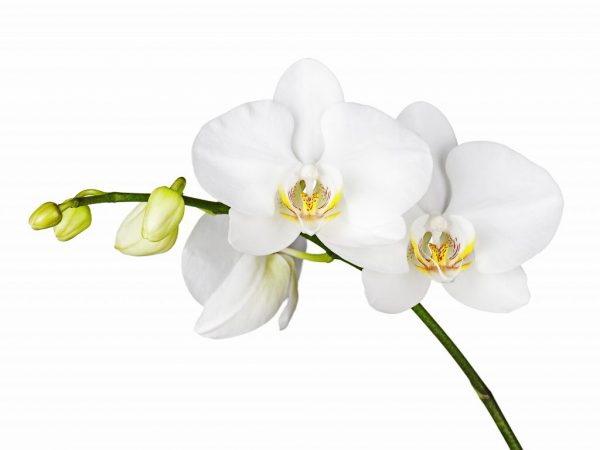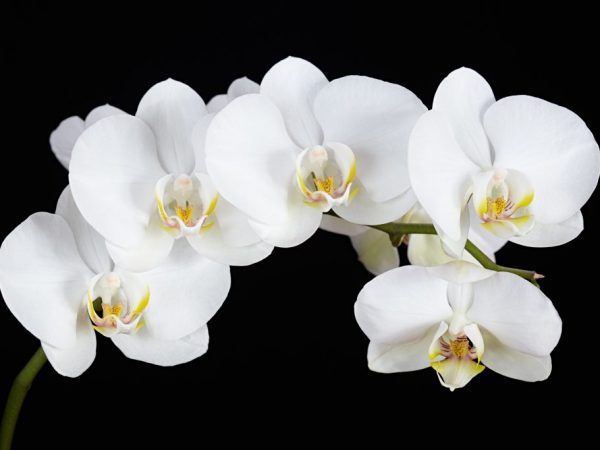Growing a white orchid
The white orchid is a symbol of masculinity. If you dreamed of a ripped off living culture, secret desires will come true, life will change for the better. The flower was bred in ancient times, because the white orchid had the meaning of love, joy and wealth. Today the butterfly flower has become a decoration of apartments and offices.

Growing a white orchid
Plant features
White orchids were discovered in 1750 by the Dutch explorer, botanist Blume. It was he who noted the striking similarity of flowers with a swarm of butterflies and gave them the name Phalaenopsis.
At home, decorative varieties with a height of 20-30 cm are bred.According to the description, white orchids growing in the wild, have a height of up to 1 m and are distinguished by larger inflorescences. The most common types are Nobile, Zarya.
A white orchid in a pot blooms all year round.
Flower appearance:
- diameter of inflorescences from 5 to 10 cm;
- snow-white orchid flowers;
- the height of the main stem is 20-100 cm;
- dark green leaves with a smooth structure;
- strong roots, requiring a powerful light source for full development.
Growing at home
White orchids are epiphyto flowers. This means that the roots must receive a sufficient amount of light for full development. To do this, they are planted in transparent pots filled with bark. When buying white Phalaenopsis in a pot, they pay attention to the condition of the root system. Healthy orchid roots have a grayish green hue.
It is important to determine the location of the plant in the room. The ideal spot for white orchids is the east and southeast side.
The flower is a photophilous plant, but it must be protected from direct sunlight, otherwise there will be burns on the leaves. The choice of pot depends on the volume of the root system. A pot is selected, into which the roots will freely enter together with the soil.
Soil preparation
For a white indoor orchid, a moisture-absorbing substrate is needed - the bark of old trees, which is collected from a pine or oak.
Pre-boil the bark over low heat for about 3 hours, and then cut into small pieces. Boiling helps to get rid of tarry substances. If there is nowhere to get bark, they use a ready-made combined substrate for plants. To prevent the spread of fungal diseases, even store-bought soil requires disinfection.
Landing
Reproduction of white orchids is possible by seeds and cuttings. Cuttings are used for planting at home. Before breeding, make sure that the plant will no longer have flowers.
The difference between the home white orchid is the long flowering period, which lasts a month or more.
Babies are formed on the main stem. When the shoots reach a length of 5 cm, they are carefully separated from the mother plant with a sharp knife and planted in a previously prepared moist substrate. The entire instrument is treated with a disinfectant.
Care

The orchid must not be dried
Caring for a representative of a variety means observing the rules of watering and feeding.
Watering is carried out by the soldering method. They take a vessel, into which a flower pot can freely enter, and fill it with water. The plant should sit in the water for about 30 minutes, until the rhizome turns bright green. Then they let the water drain and put the pot in place.
The next watering is carried out when the root system again acquires a gray-green tint.
Proper care of a white orchid implies the regular introduction of vitamin and mineral complexes. For the full development of plants, preparations Forte, Pokon are suitable.
White orchids are fed from March to September. Mineral complexes are diluted in water according to the instructions and alternated with watering with plain water.
Orchids bloom for about a month. The main thing is not to rush into pruning. When flowering has finally stopped, the main stem is cut off, leaving 3-5 buds.
Common diseases
There are certain signs of poor care: orchids do not bloom when the irrigation regime is violated, the temperature in the room often changes or there is not enough light. With a lack of light, light green stripes appear on the leaves. The yellowness of the deciduous part indicates an overabundance of ultraviolet rays.
One of the problems of culture is rotting of the root system. The disease is difficult to define. Root decay is the result of too much watering. If other mistakes in care are easy to correct, then only a transplant will help with decay.
A large white orchid can shed its lower leaves on its own. This is a normal process for self-regulation of growth. If a blooming orchid is covered with grayish spots, water got on the flowers during watering. Brown spotting is a symptom of a fungal disease. In such cases, the plants can no longer be helped.
Prophylaxis
To prevent bacterial rot, the soil is periodically treated with fungicides. If signs of the disease appear on the leaves, they are cut with a knife and treated with copper sulfate. Powdery mildew is removed with Fitosporin solution.
Be sure to observe the temperature regime. The optimum temperature is 20 ° C, the humidity is at least 60%. In the summer, the plants are regularly sprayed, preventing the accumulation of liquid in the rosette of leaves.
Conclusion
The white orchid is called Phelanopsis, which means "butterfly". The most common species range in color from pale pink to white. Proper care is the key to long-lasting flowering and good immunity in plants.
For these flowers, a separate window sill is assigned, they are not placed close to each other: this way it is possible to reduce the risk of infection with viruses and fungi. Regular transplantation and removal of dried roots serves as a prophylaxis against many diseases. All manipulations are carried out under sterile conditions.


